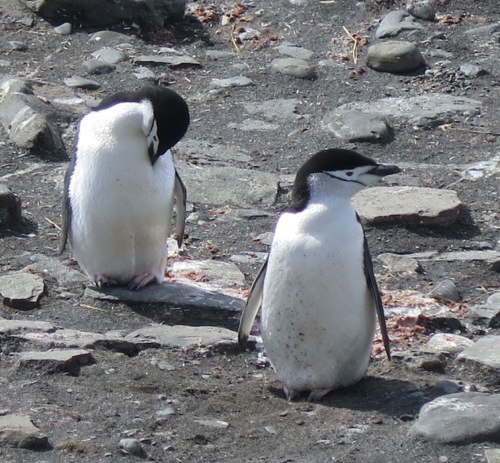Penguins that is
 A small cove on Annenkov island, an ecological menagerie of wild beauty.
A small cove on Annenkov island, an ecological menagerie of wild beauty.
The weather has been marvelous, so one more attempt was made to put in the third and final GPS. With approval from the South Georgia government, we set off for Annenkov Island, just south of the Main South Georgia Island. And guess what... I was allowed to go ashore and assist the GPS team, document, and learn a bit about the wildlife.
 King penguins: Aptenodytes patagonicus
King penguins: Aptenodytes patagonicus
Greetings to the king penguin, the second largest penguin at 85 - 95 cm. King penguins do not build nests like the Gentoo we saw in a previous entry. The king's single egg is incubated on their feet under a specialized flap of skin. The diet of the king penguin is predominantly squid and lantern fish. We were very lucky to see both adults and young.
 This chick should be ready to fledge in a few months and then the breeding cycle for the adults will start again.
This chick should be ready to fledge in a few months and then the breeding cycle for the adults will start again.
Our chicks appear to be about 11 months old, getting ready to fledge, and were probably born late last January. This December our young ones will be ready to take care of themselves, and will mature enough to breed for another five to eight years.
 Our very large chick is still dependent on the adult for food.
Our very large chick is still dependent on the adult for food.
We also had the opportunity to see a pair of chinstrap penguins -- a smaller species at 70 - 75 cm. Chinstrap penguins lay eggs in late November, and are monogamous, forming long lasting pair-bonds. Currently the chinstrap penguin is near threatened
 The little Chinstrap penguins look for a place to build their nest of small pebbles and bones.
The little Chinstrap penguins look for a place to build their nest of small pebbles and bones.
Our little stretch of cove had so much life. Besides penguins, I also managed to catch a snowy sheathbill. The sheathbill also lays its eggs in a nest of pebbles, usually in a rocky cavities. According to the book I have been using, the sheathbill is an omnivorous feeder, which we saw as it moved in and out of the seal colony, looking in the poo of the seals.
 The snowy sheathbill are foragers and were always looking for some scrap that we might drop for their delight.
The snowy sheathbill are foragers and were always looking for some scrap that we might drop for their delight.
It is the start of spring here in the southern hemisphere and
everything appears to be getting ready for breeding and raising young.
The South Georgia pintail can lay up to five eggs, and often nests in
tussocks. The grass on the island is very unique, and I say grass
lightly, as it is a dense think mound, appears quite durable, and is home
to many species. The South Georgia pintail also has a period of time
when it molts and is unable to fly, and from mid January to possibly April,
the bird becomes strictly nocturnal.
 The South Georgia pintail is a diurnal species that when molting becomes nocturnal, pretty amazing adaptation.
The South Georgia pintail is a diurnal species that when molting becomes nocturnal, pretty amazing adaptation.
Today was more than a good day, it was a life day. One of those days when the memory lasts and you know that your life will never be the same. I thought of my grandfather a lot today. He was an avid birder, and no question the first person in my life to kindle my love of birds.
 Today was one of those amazing life days. Thank you!
Today was one of those amazing life days. Thank you!
Stay tuned until tomorrow when we will talk more about the GPS station on Annenkov Island, and then in two days we move into the land of fur seals and the southern elephant seal.
 Keep checking back, you don't want to miss the southern elephant seal blog.
Keep checking back, you don't want to miss the southern elephant seal blog.

Comments